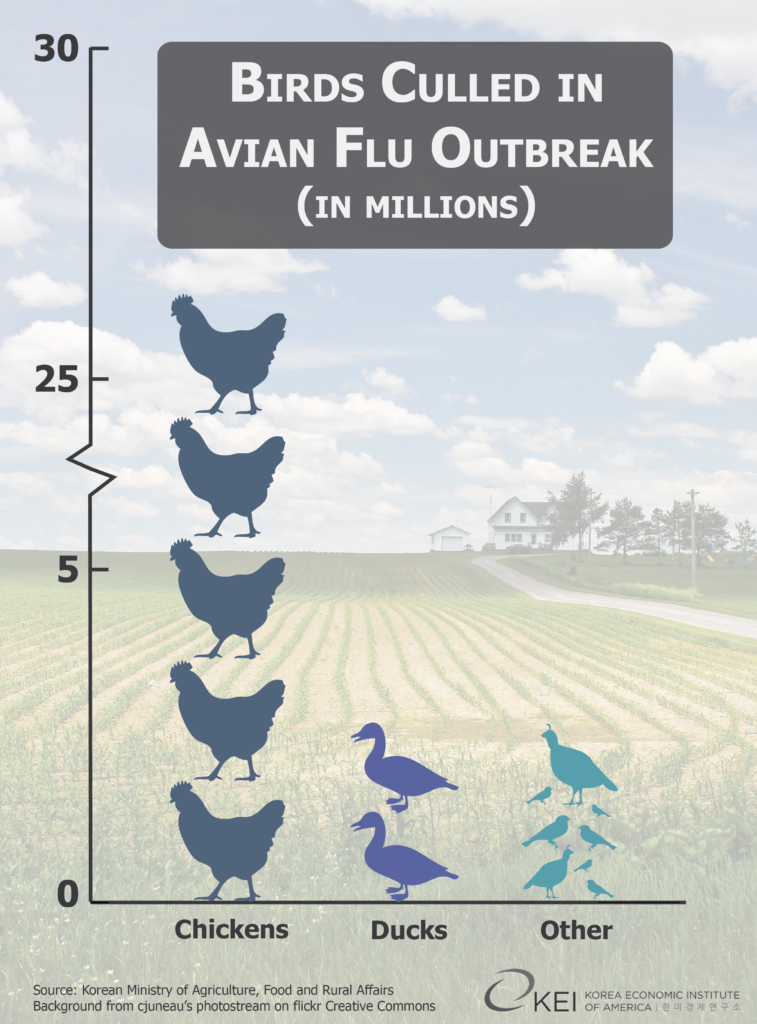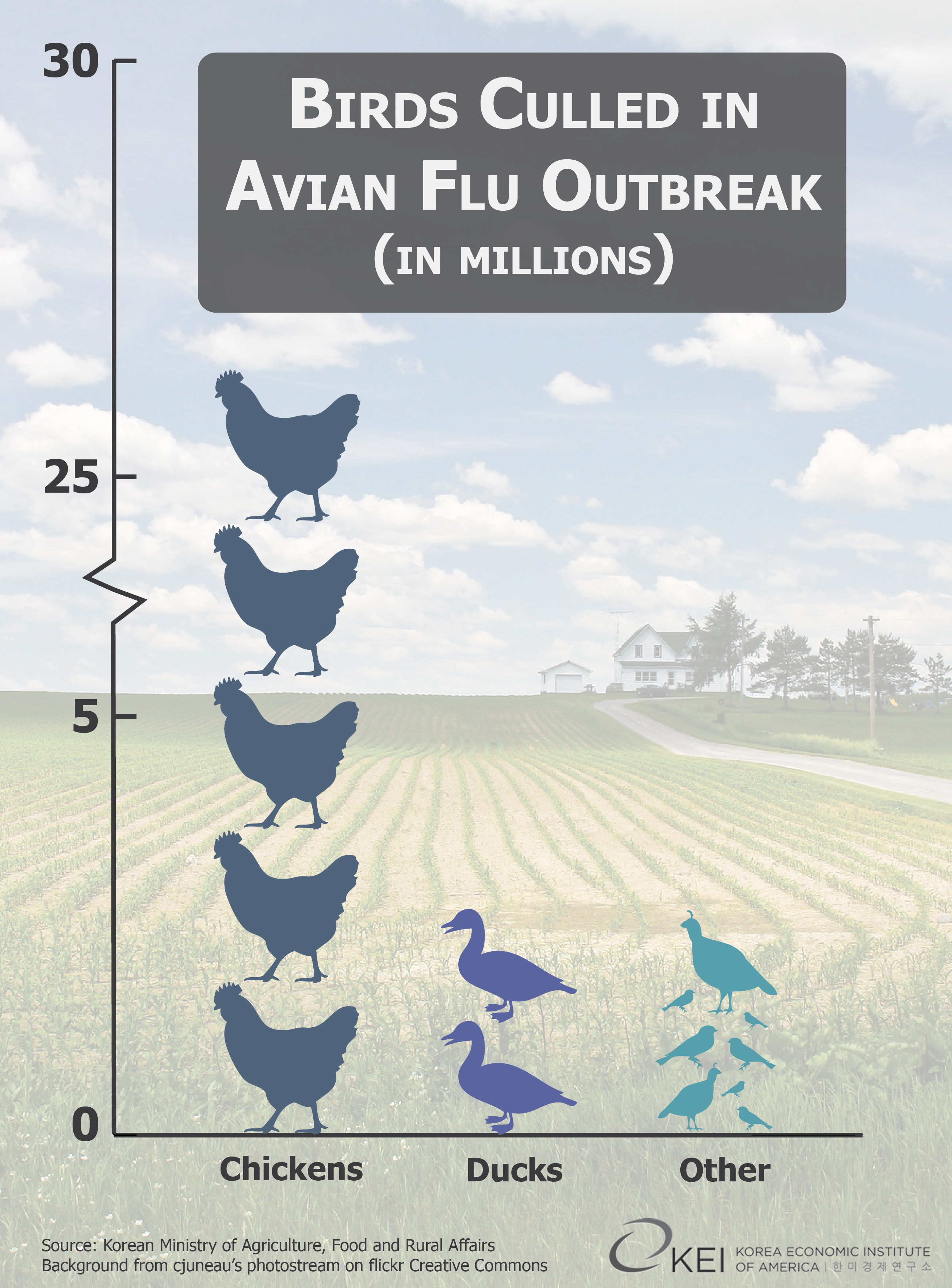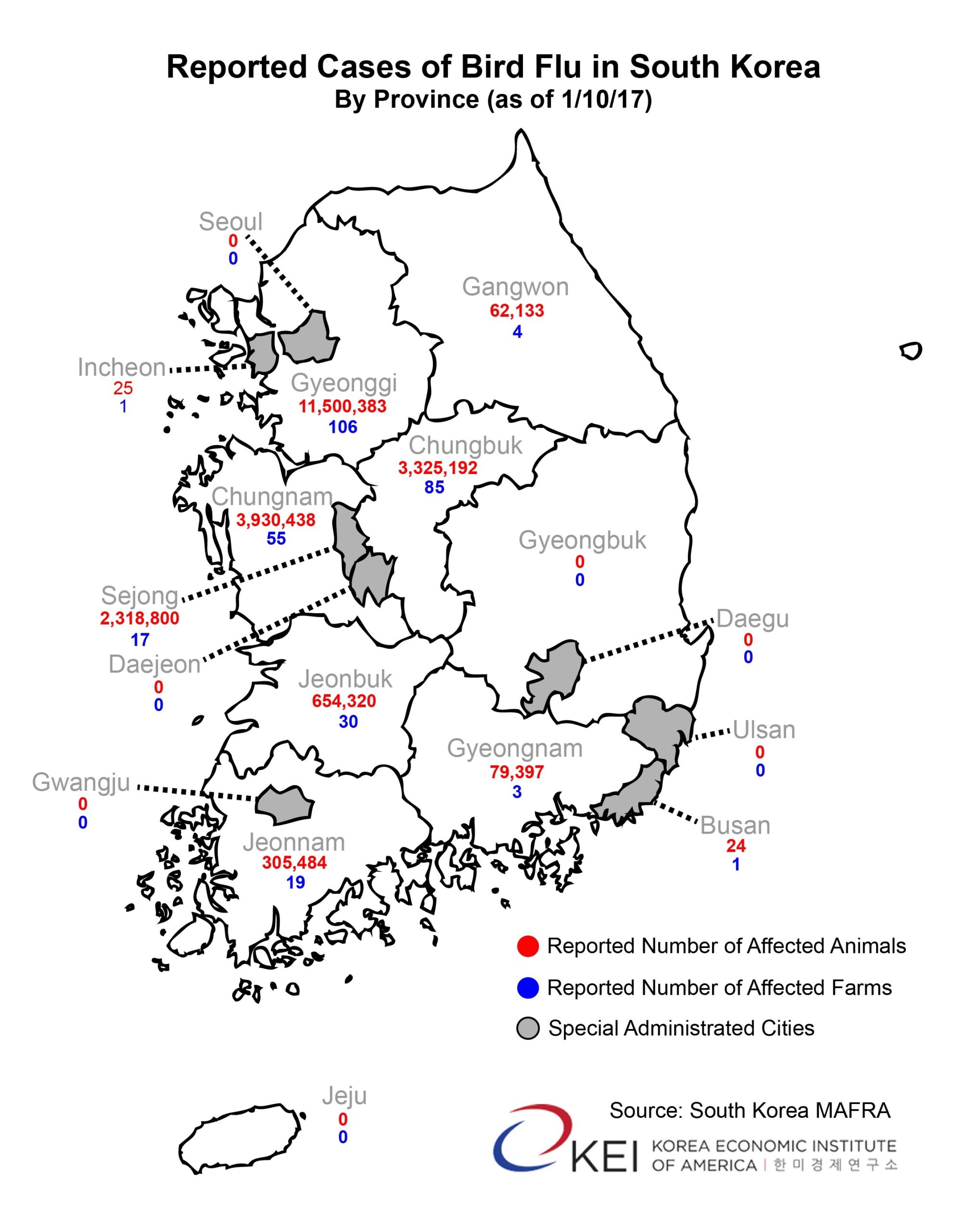The Peninsula
South Korea’s Struggle Against Avian Influenza
Published January 12, 2017
Category: South Korea

By Juho Choi
Since the end of 2016, the Korean government has faced a variety of problems from a major political scandal to a stagnant economy. Among the issues, one of the most urgent is Avian Influenza (AI).
According to the WHO, Avian influenza (“bird flu”) is “an infectious disease of birds caused by type A strains of the influenza virus. The infection can cause a wide spectrum of symptoms in birds, ranging from mild illness, which may pass unnoticed, to a rapidly fatal disease that can cause severe epidemics.” Since 2003, more than 8,000 outbreaks of AI have been reported all around the world.
In the case of South Korea, the more contagious and deadly N5H6 strain of AI has infected birds and the first definite diagnosis was on November 17th 2016 in Haenam-gun and Eumseong-gun. Since then, it has swept across the South Korean peninsula, reaching every province except Gyeongsangbuk-do and Jeju Island, and 26.7 million chickens, 2.5 million ducks, and 2.5 million other birds have been slaughtered.
 The slaughter of chickens has reduced the supply of eggs, causing the retail price of eggs to soar. The country’s daily egg output has been cut by 30 percent to just 30 million. The average price of a carton of 30 eggs came to 8,237 won as of Dec.30, up 52.2 percent from 5,410 won on Nov 29. In order to stabilize the egg market price, the government officially announced it would lift an import tariff which usually runs from 8 to 30 percent until June 30. Furthermore, they has decided to minimize the hygiene evaluation procedure for the U.S. eggs and subsidize 50% of total air shipping cost. In the case of the U.S., this is the first export of U.S. eggs to South Korea. However, since consumers and industry are suspicious of the quality of imported eggs and their shipping procedure, the egg price will be unstable for a while.
The slaughter of chickens has reduced the supply of eggs, causing the retail price of eggs to soar. The country’s daily egg output has been cut by 30 percent to just 30 million. The average price of a carton of 30 eggs came to 8,237 won as of Dec.30, up 52.2 percent from 5,410 won on Nov 29. In order to stabilize the egg market price, the government officially announced it would lift an import tariff which usually runs from 8 to 30 percent until June 30. Furthermore, they has decided to minimize the hygiene evaluation procedure for the U.S. eggs and subsidize 50% of total air shipping cost. In the case of the U.S., this is the first export of U.S. eggs to South Korea. However, since consumers and industry are suspicious of the quality of imported eggs and their shipping procedure, the egg price will be unstable for a while.
Meanwhile, the price of chicken has dropped due to growing safety concerns. According to the Korea Broiler Council, the price of 1kg of chicken was 1,490won as of Jan 2, down 22.2 percent from 1,890 won on Nov.16. However, according the report from Korea Rural Economic Institute (KREI), the huge decrease of chicken supply will help the price of chicken recover to its usual level.
Response of the Korean Government
 On November 18, two days after the first AI diagnosis, the Korean government organized a task force to prevent the spread of the virus. The authorities banned poultry related vehicles movement within a 10-kilometer radius of farms where the virus was reported. Furthermore, they raised the watch level from ‘alert’ to ‘caution’ and prohibited the distribution of live poultry. However, the effect was minimal and additional infections were reported in Gyeonggi-do.
On November 18, two days after the first AI diagnosis, the Korean government organized a task force to prevent the spread of the virus. The authorities banned poultry related vehicles movement within a 10-kilometer radius of farms where the virus was reported. Furthermore, they raised the watch level from ‘alert’ to ‘caution’ and prohibited the distribution of live poultry. However, the effect was minimal and additional infections were reported in Gyeonggi-do.
Acting President Kyo ahn Hwang held a conference of ministers on December 12 and ordered officials to intensify the quarantine system and expand the quarantine rules to related officers and operators. For the sake of poultry-farms, the government decided to support a loan program to people who earn a living from poultry related industries. Furthermore, quarantine authorities decided to call for a nationwide standstill of poultry related vehicles on December 13 and raised the watch level from ‘caution’ to ‘serious’.
In spite of the government’s persistent efforts, high contagious AI has rapidly spread nationwide. On December 24, additional AI infections were reported from Yang-san and Kyung-san in Gyeongsang-Do and more than 27 million poultry had been slaughtered and buried by December 27.
Jae Hong Kim, Veterinary Science Professor of Seoul National University, pointed out the late response of the government and the disregard of the government orders at infectious sites worsened the worst AI disaster. He added the Korean government should revise the structure of authorities and increase the quarantine expertise on site.
Response of the Japanese Government
On November 18 and 21, potential AI viruses were reported from the excrement of migratory birds in Japan. The Japanese government raised the watch level to the highest level in order to observe the situation. Ten days after the first suspicious report, the first confirmed AI case occurred in Aomori province. Ten ducks were found dead and the farm owner reported it to the Japanese government promptly. The government launched an investigation within an hour and prohibited the movement of eggs and duck eggs within a 10-kilometer radius of the farm. At midnight, authorities confirmed the diagnosis and slaughtered 16 thousand ducks following procedure. Furthermore, they set up five quarantine facilities near the farm to prevent the spread.
Meanwhile, in Nigata province AI was discovered on the same day. Authorities followed the same procedure and slaughtered 32 thousand ducks. Shinzo Abe, the Prime Minister of Japan, held a conference of ministers on November 19and emphasized the importance of initial response. At the same time, the Department of Agriculture, Forestry and Fisheries organized quarantine authorities. The AI seemed to have disappeared, but a new outbreak occurred two weeks later. Ninety-seven thousand birds had been slaughtered and buried by December 29.
Due to the prompt response and whole governmental effort, Japan has so far been able to minimize the AI damage.
Transfer Possibility to Other Species
On December 31, the H5N6 strain of AI was discovered in two dead cats at Pocheon, 46 kilometers north of Seoul. The Korean government launched an investigation into how the AI virus was transferred from birds to mammals. Since the N5H6 AI virus has high lethality and can spread rapidly, the possibility exists that the N5H6 strain of AI can be transferred to other mammal species, including humans, and cause a deadly epidemic like Swine flu in 2009. On January 3, the Korean government reported that another street cat was infected with AI from the dead cat. However, they couldn’t find the AI virus in two dogs which had contact with the two dead cats. The Korean government officially reported that the AI infection possibility from cat or poultry to human seemed low citing an experiment result from Song Dae Sub, a veterinary science professor at Korea University. Following his experiment, he used a ferret, which has nearly the same pathology as a human. He found no AI infection between poultry or cat to the ferret. Furthermore, the Korean government added that the H5 strain of AI, which was found in the dead cats, rarely infected humans but that the situation would be watched closely.
Nonetheless, despite the best efforts of the government people are showing growing concern about AI infection.
Juho Choi is an intern at the Korea Economic Institute of America and a student of the Dong-A University in Busan. The views expressed here are the author’s alone.
Photo from USAID Asia’s photostream on flickr Creative Commons.
